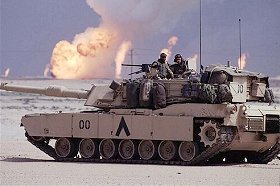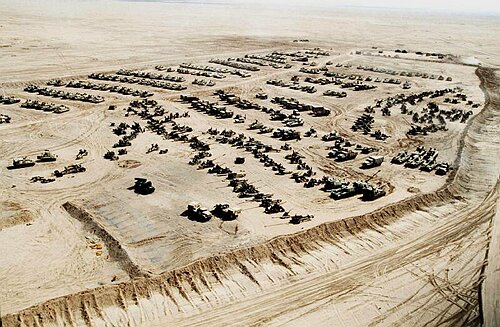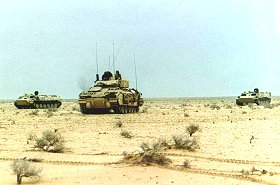While most of the Tawakalna Division commander's attention was focused to his division's front, its right flank was about to be attacked by a fourth American unit, the 1st Armored Division. Major General Ron Griffith's primary military target had been the Medina Division about thirty kilometers father east, but one battalion of the Tawakalna's 29th Mechanized Brigade occupied positions in Griffith's 1st Armored Division's zone of operations. That Iraqi battalion lay directly in the path of Colonel Dan Zanini's (one of Griffith's three maneuver brigades) 3rd Brigade, 1st Armored Division.

Colonel Zanini synchronized the fight to maximize his fire power and minimize battlefield confusion. Artillery, Apache attack helicopters and mechanized infantry fired their weapons at the Iraqi defenders in order to prevent them from returning accurate fire as one of his tank battalions (Task Force 1-37 Armor) began moving in the dark towards the Iraqi defenses. This battalion's forty-five M1A1 tanks moved abreast towards the Iraqis at less than ten kilometers per hour. About 1,000 meters behind the tanks moved the battalion's infantry company mounted on its Bradleys, to help destroy any threat to their rear. As the tanks moved forward, the overwatching infantry battalion began firing illumination rounds from its mortar platoon. The brigade commander then turned the fight over to the battalion commander, Lieutenant Colonel Ed Dyer.
As was the case with the entire Tawakalna division, the Iraqi soldiers fought hard. Many Iraqi tanks kept their engines off in order to defeat the American thermal sights. Those vehicles were often located because of the strange white spots, the tank commander's head, seemingly suspended in thin air. The Iraqi tanks that were not hit were able to turn their turrets and attack the M1s in their flanks and rear. Iraqi infantry moved in three to five second rushes in order to get close to attacking vehicles. Burning vehicles and explosions "washed out" the thermal sights and made it difficult for US forces to locate Iraqi tanks. In that confusion, the 29th Iraqi Armored Brigade knocked out four M1 tanks, wounding six US soldiers.

The Iraqi brigade, however, never had a chance. It was attacked by Task Force 1/37 Armor, the tank battalion with the best gunnery skills in the entire US Army.60 When TF 1/37 had completed its assault, the Iraqi unit was in shambles. Because of luck, training, and the effectiveness of the Abrams' enhanced armor, there were no American fatalities. In the sector swept by the 1st Brigade, two Iraqi tank companies and one mechanized infantry company (approximately 24 T-72 tanks and 14 BMP infantry fighting vehicles) had become burning hulks.
At the same time the American ground forces were demolishing the front line of the Tawakalna, US attack helicopters, jet aircraft, and artillery were simultaneously attacking the Iraqi division throughout the depth of its defensive zone. The primary targets included artillery batteries, command posts and supply depots.

Iraqi soldiers with their T62 tanks anxiously await a U.S. officer, to discuss a site for official surrender talks.
As soon as the 2nd Armored Cavalry Regiment made contact with the Tawakalna Division around 4:30 pm, 26 February, the battle began. Artillery from the Regiment's field artillery batteries and the 210 Field Artillery Brigade pounded the second line of Iraqi troops. Those missions destroyed troops and supply installations and interfered with the Tawakalna's command and control. The 2/1 Attack Helicopter Battalion, working for the 2nd Armored Cavalry Regiment, struck at artillery and support areas to the rear of the Iraqi lines. It destroyed at least two artillery batteries and dozens of vehicles and support installations along the IPSA Pipeline road.
This assault continued until the 1st US Infantry Division passed through the 2nd Armored Cavalry Regiment. The 1/1 Attack Helicopter Battalion then attacked the 18th Iraqi Mechanized and 9th Iraqi Armored Brigade's second line of troops at 9:00 pm, on 26 February. The attack prevented the Iraqi artillery from interfering with the 1st Infantry's passage of lines. From the time the 2nd Armored Cavalry Regiment made contact, on the night of 26 February, until the following morning when the 1st Infantry Division cleared Objective Norfolk, the Iraqi soldiers of the 18th and 37th Brigades received no respite from constant ground, artillery, and air attack.

British troops guard captured Iraqi armor and weapons in the Kuwaiti desert.
The situation was the same in the US 3rd Armored Division zone of operations. Its constant pounding of Iraqi combat and combat service support units made Iraqi counterattacks, resupply or reinforcement almost impossible. Those incessant attacks destroyed Iraqi artillery, broke up units assembling for counter-attacks, and thoroughly disrupted Iraqi command and control. When the 3rd Brigade passed through at dawn on 27 February, there were no more Iraqi strong points to slow the attack. The Iraqi commander had no way of countering the effects of these deep attacks. He had no choice but to stand and fight or surrender. Most of the soldiers in this proud division, like its commander, fought and died.

